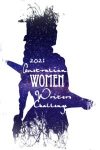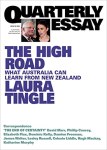One of the reasons I love reading fiction is to be introduced to lives and cultures I know nothing about. This is less so in nonfiction, but Sarah Krasnostein’s latest book, The believer, fits the brief. In it she explores questions concerning what people believe and why through six different people (or groups of people), all of which were foreign to me.
The six “beliefs” are eclectic, but can be divided into three categories : personal lives (a death doula and a woman who had been incarcerated for over 30 years for murdering her violent husband); religious lives (through a Creation Museum and some Mennonite families); and the unexplainable (paranormal seekers/ghostbusters and ufologists). These six “cases” all come from either the USA or Australia.
Different readers will be drawn to different ideas in the book, but in my reading group, the most popular were the two personal stories – death doula Annie, and ex-prisoner Lynn. Lynn’s story of abuse at her husband’s hands first and then the justice system’s was heart-rending. Yet Lynn had come to understand that she’d made choices, and had gone on to use her life to make things better for others. Inspiring.
The book has a disjointed three-part structure, with one of each of the three categories explored in “Below”, the remaining three in “Above”, and then some reappearing in the final “Coda: Here” section. Within these sections, the stories are told over several alternating chapters, so no one story is told in one go. One of the questions my reading group discussed was whether this structure helped or hindered our reading. We didn’t resolve this, though the overall consensus seemed to be that the alternating did keep us interested. There was probably method to the placement of the stories, but it wasn’t always clear to us, which might be more to do with the time of year and our concentration levels.
Lightbulb moments
What we did all agree on, however, was that the book had some great lightbulb moments – and for many of us, it’s the lightbulb moments that make a book special or memorable.
One refrain that ran through the book was that life isn’t easy or simple. Mennonite Becky says that “life isn’t just a bed of roses”, and ex-prisoner Lynn understands that “pain is a part of life”. Ufologist Jaimie has a more positive spin, seeing that life “is not just going to work and dying”. There are mysteries out there to explore.
However, for me, the most significant moment occurred in “Before”, in a Paranormal/Vlad chapter. It concerned the need for certainty. Krasnostein references German neurologist, Klaus Conrad, who coined the term apophenia, which essentially means that we look for meaning and coherence, and will go so far as to perceive them in unrelated events and ideas. We will, writes Krasnostein, “choose certainty over accuracy”. “We are compulsive converters of fact into meaning”.
I hope I’m not oversimplifying, but Krasnostein then cites a Science article which talks about the human desire to “combat uncertainty and maintain control” and the importance of this to psychological wellbeing and physical health. You can probably see the lightbulb here: it explained, to me, why some people have found the pandemic harder to handle than others, and why some people can become susceptible to conspiracies. People who feel out of control will look for patterns and answers. For me, living with questions is interesting – and in fact real, because I’m not sure there always are answers – but I feel I better understand now, those who do not feel this way, those who demand certainty, such as “promise there will be no more lockdowns”. I better understand why people might turn to conspiracies when authority doesn’t (indeed, sometimes can’t) provide consistent answers.
Other lightbulb moments were less applicable to my life, but were interesting nonetheless. An example was the Mennonites fear of higher education. It “contains an unacceptable risk of assimilation”, potentially causing tertiary educated members to leave the community (the Mennonite kingdom) and be assimilated into wider society. Higher education threatens their understanding of the world, their faith in the Bible as explaining the world. Krasnostein writes of one Mennonite man who had moved to New York in a mission “to make a difference in people’s lives”:
Anthony’s conflict comes from the fact that the certainties he received instead of education are poor tools for daily living.
There’s that idea of certainties again. Anthony tells Krasnostein that “Theology always scares me because it takes the things that seem simple and makes them complex”. This too returns us to the idea of certainties. Anthony sees life simply. In the Mennonites’ belief in a “loving presence”, they see (create?) “a perfect pattern embroidered into the fabric of reality”. Patterns, again.
What added to the book’s interest was that Sarah Krasnostein was, herself, searching to understand “belief”. She admits to occasionally envying Anthony and his co-believers’ “refusal to accept the absence of evidence as the evidence of absence”. She says at one point, “If I could only ask the right questions I could understand”.
This has not been one of my typical review posts, partly because this is a different sort of book, but mostly because I finished it nearly two weeks ago and am not in the brainspace for doing my usual thing. Forgive me. However, you should be grateful, because this book is jam-packed with stories – some tragic, some poignant, some inspiring and some, I have to admit, infuriating (I’m looking particularly at you Creation Museum) – and it would have been tempting to share too many of them. They weren’t, of course, all equally interesting. And occasionally, they got a bit bogged down in detail to the point that I risked losing the thread. That’s the challenge Krasnostein faced in meeting so many people and wanting to explore all their thoughts and ideas. Overall, it works. Her lyrical prose, and warm, open heart play a big role in that.
Talking about UFO sightings, ufologist Ben tells Krasnostein that “we need to find all these little stories. They build up into a big matrix of stories” which, for him, might locate the “truth” of the events. However, this is also exactly what Krasnostein did in this book and, in doing so, she found, as she writes at the end,
six different stories, six different notes in the human song of longing for the unattainable.
My reading group was a little disappointed that in the Coda, Krasnostein didn’t give us a clear summation of the sort you often find in nonfiction works. In fact, though, I think Krasnostein did find something very real, a belief that could help us accept each other’s wildly different shores a little more: it’s that we are “united in the emotions that drive us into the beliefs that divide us”. That is quite profound, and worth spending some time absorbing.
Sarah Krasnostein
The believer: Encounters with love, death and faith
Melbourne: Text Publishing, 2021
351pp.
ISBN: 9781922330208








 The conversation centred around the recent release of Garner’s Yellow notebook: Diaries, Volume 1, 1978-1987, so the conversation began by discussing both diary writing and the process of preparing them for publication. Krasnostein, who asked rather long but always thoughtful questions, talked about the role and function of diaries, suggesting they exist for their own sake but are also works in themselves. Garner’s diaries, she said, contain harvested and preserved details from the world, but also show Garner’s “fearless self-scrutiny”, plus “the things one can think but not say”. Garner said that she has always loved notebooks and pens, and how as a child she loved the peace and solitude she got from writing her diaries.
The conversation centred around the recent release of Garner’s Yellow notebook: Diaries, Volume 1, 1978-1987, so the conversation began by discussing both diary writing and the process of preparing them for publication. Krasnostein, who asked rather long but always thoughtful questions, talked about the role and function of diaries, suggesting they exist for their own sake but are also works in themselves. Garner’s diaries, she said, contain harvested and preserved details from the world, but also show Garner’s “fearless self-scrutiny”, plus “the things one can think but not say”. Garner said that she has always loved notebooks and pens, and how as a child she loved the peace and solitude she got from writing her diaries.
